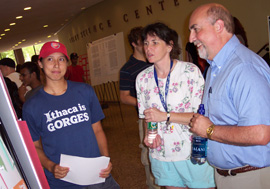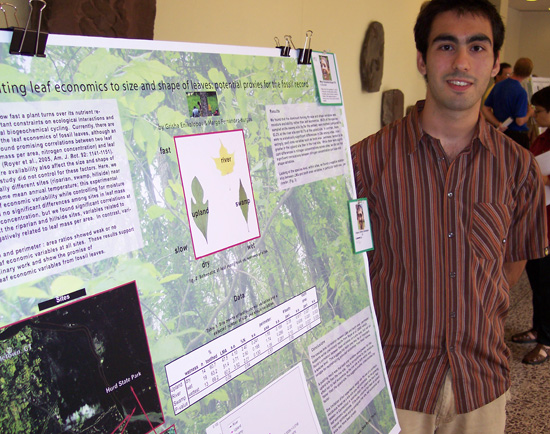|
When Grigori Enikolopov 08 studied the leaf economics in river, swamp and upland areas, he found that the wetter the area, the more ridges or teeth the leaves of woody tree species possessed.
During the Hughes Program in the Life Sciences Poster Session Aug. 4, Enikolopov, explained that 70 percent of the trees in a swamp have teeth compared to 60 percent in the upland areas. He posted his findings on a poster board and titled his work, Relating Leaf Economics to Sizes and Shapes of Leaves: Potential Proxies for the Fossil Record.
 This was a great way to study science, he explains. We had the opportunity to do real research. I hope in the long term I can apply what Ive done with a career in conservation or scientific documentaries. This was a great way to study science, he explains. We had the opportunity to do real research. I hope in the long term I can apply what Ive done with a career in conservation or scientific documentaries.
Enikolopov was one of 50 undergraduate research fellows who presented their research in the Exley Science Center. He and his peers have been working on their projects during the past 10 weeks under the tutelage of Wesleyan faculty advisors. Enikolopov and his project partner, Margo Fernandez-Burgos 09, studied with Dana Royer, assistant professor of earth and environmental science.
The poster session allowed the research fellows to present their research to faculty, graduate students, fellow undergraduates and other visitors. This year, area high school teachers and prospective undergraduate applicants also attended the event.
The poster session provides a sense of the spirit and accomplishments of our undergraduates’ research experience this summer, explains Michael Weir, professor of biology and director of the Hughes Program in the Life Sciences. Stepping back to communicate the logic of your research in a poster presentation is very important for thinking about where you have traveled in your research field and where you might go next. Students feel the excitement of discussing and interpreting their research, and experience what it can be like to be part of the community of scientists.
Chemistry Major Katrina Adams ’07 presented her project “Oxidation of 1-Trimethylslyl-2-Phenylethane and 1-trimethylsilyl-3-Phenylpropane,” with the help of Albert Fry, professor of chemistry. Adams hoped to see if a primary carbocation – a short-lived highly reactive molecule – is formed when the compound is oxidized.
Most chemists think a primary carbocation cannot be made, Adams explains, pointing to diagrams of chemical models. We hope to show that the primary carbocation is possible for these two molecules.
 Adams, who began similar research in 2003, plans to continue the study until she graduates. Adams, who began similar research in 2003, plans to continue the study until she graduates.
Psychology major Azeb Gebre 07 studied The Association between Age of Immigration into the United States and the Prevalence of Substance Use among Foreign-Born Youths in America, with associate professor of psychology Lisa Dierker as her advisor. She analyzed data presented in a 2002 survey on drug use and health database.
What I found is that the age of entry to United States is related to substance abuse. The younger someone is when they come to the country, the higher chance they have of using nicotine, marijuana or alcohol, Gebre explains, peering over graphs on her poster. I think this is because it becomes more socially acceptable for them.
Among the other 54 projects displayed at the poster session were Phil Zegelbones 08 study on embryonic, larval, juvenile and adult myogenesis; Renee Sher’s 07 study on hydrogen fuel storage safety; Rebecca Straley’s 07 study on the tectonics of Tellus Regio, Venus. Zegelbone worked with Stephen Devoto, associate professor of biology and neuroscience and behavior; Sher worked with Fred Ellis, professor of physics; and Straley worked with James Greenwood, visiting assistant professor of earth and environmental sciences.
Students from the biology, molecular biology and biochemistry, math and computer science, chemistry, psychology, earth and environmental sciences and physics departments participated.
The Hughes grant is funded by the Howard Hughes Medical Institute to encourage participation and interest in the life sciences by undergraduates. The grant supports summer research and includes a stipend and participation in Hughes activities.
For more information on the Hughes Program for Life Sciences, visit http://www.wesleyan.edu/hughes/.
|



 This was a great way to study science, he explains. We had the opportunity to do real research. I hope in the long term I can apply what Ive done with a career in conservation or scientific documentaries.
This was a great way to study science, he explains. We had the opportunity to do real research. I hope in the long term I can apply what Ive done with a career in conservation or scientific documentaries. Adams, who began similar research in 2003, plans to continue the study until she graduates.
Adams, who began similar research in 2003, plans to continue the study until she graduates.